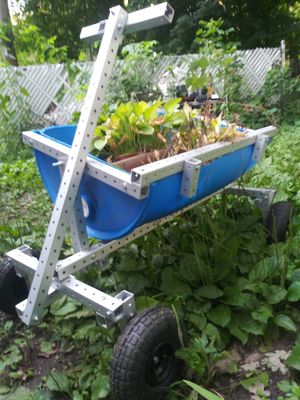Carts: Difference between revisions
No edit summary |
|||
| (13 intermediate revisions by the same user not shown) | |||
| Line 1: | Line 1: | ||
=== | {{Projects infobox | ||
|image = WagonHosta.jpg | |||
|designers = | |||
|date = | |||
|vitamins = | |||
|materials = | |||
|transformations = | |||
|lifecycles = | |||
|tools = [[Wrenches]] | |||
|parts = [[Frames]], [[Nuts]], [[Bolts]], [[Plates]], [[End caps]], [[Barrels]] | |||
|techniques = [[Shelf joints]], [[Tri joints]] | |||
|files = | |||
|git = | |||
|suppliers = | |||
}} | |||
[[Category:Projects]] | |||
[[Category:Agriculture]] | |||
=Introduction= | |||
A cart or dray (Aus. & NZ) is a vehicle designed for transport, using two wheels and normally pulled by one or a pair of draught animals. A handcart is pulled or pushed by one or more people. | |||
It is different from the flatbed trolley also known as a dray, (for freight) or wagon, which is a heavy transport vehicle with four wheels and typically two or more humans. | |||
Over time, the term "cart" has come to mean nearly any small conveyance, including shopping carts, golf carts, gokarts, and UTVs, without regard to number of wheels, load carried, or means of propulsion. | |||
The draught animals used for carts may be horses, donkeys or mules, oxen, and even smaller animals such as goats or large dogs. | |||
=Challenges= | |||
Many loads are too heavy to carry by hand. Many tasks too strenuous to complete by hand. | Many loads are too heavy to carry by hand. Many tasks too strenuous to complete by hand. | ||
= | =Approaches= | ||
Wheelbarrows, moving dollies, and other carts make impossible jobs possible, and hard | Wheelbarrows, moving dollies, and other carts make impossible jobs possible, and hard | ||
jobs easy. Two large wheels on either side aid stability with heavy loads across rough | jobs easy. Two large wheels on either side aid stability with heavy loads across rough | ||
terrain. | terrain. | ||
<gallery> | <gallery> | ||
WagonHosta.jpg|Replimat Wagon v0.1 | WagonHosta.jpg|Replimat Wagon v0.1 | ||
| Line 26: | Line 43: | ||
</gallery> | </gallery> | ||
=== | =Interoperability= | ||
=Development targets= | |||
Double-thickness coroplast tub w/ folded-over edges for triple thickness and smooth edge | |||
[ | =References= | ||
* [https://en.wikipedia.org/wiki/Cart Wikipedia: Cart] | |||
Latest revision as of 06:02, 23 September 2021
| Tools: | Wrenches |
|---|---|
| Parts: | Frames, Nuts, Bolts, Plates, End caps, Barrels |
| Techniques: | Shelf joints, Tri joints |
Introduction
A cart or dray (Aus. & NZ) is a vehicle designed for transport, using two wheels and normally pulled by one or a pair of draught animals. A handcart is pulled or pushed by one or more people.
It is different from the flatbed trolley also known as a dray, (for freight) or wagon, which is a heavy transport vehicle with four wheels and typically two or more humans.
Over time, the term "cart" has come to mean nearly any small conveyance, including shopping carts, golf carts, gokarts, and UTVs, without regard to number of wheels, load carried, or means of propulsion.
The draught animals used for carts may be horses, donkeys or mules, oxen, and even smaller animals such as goats or large dogs.
Challenges
Many loads are too heavy to carry by hand. Many tasks too strenuous to complete by hand.
Approaches
Wheelbarrows, moving dollies, and other carts make impossible jobs possible, and hard jobs easy. Two large wheels on either side aid stability with heavy loads across rough terrain.
-
Replimat Wagon v0.1
-
Replimat Wagon v0.1
-
Replimat Wagon v0.1
-
Replimat Wagon v0.1
-
Replimat Wagon v0.1
Interoperability
Development targets
Double-thickness coroplast tub w/ folded-over edges for triple thickness and smooth edge





